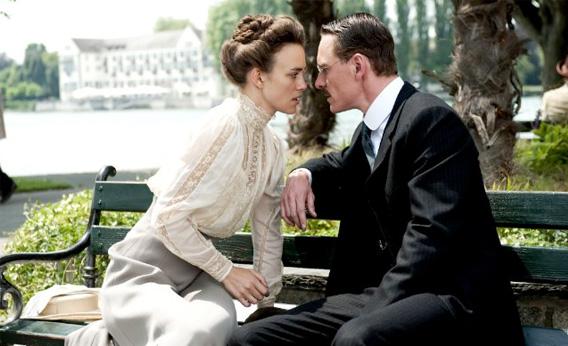It makes sense that David Cronenberg, one the great cinematic thinkers about sexuality, repression, violence, death, and other riddles of bodily existence, would be drawn to the idea of making a film about the break between Sigmund Freud and Carl Jung. What’s surprising is that the resulting movie, A Dangerous Method (Universal Pictures), doesn’t include, say, a fantasy sequence in which a polyp growing in Jung’s mouth takes on a life of its own, invades Freud’s body and infects it with a slow poison, thereby literalizing the student’s death wish for his mentor.
Did a part of me want something like that to happen? Sure. Some of Cronenberg’s earlier films (Dead Ringers and Videodrome come to mind) have blown my mind as much as any movie ever did. But Cronenberg’s more recent work has been moving away from metaphysical body horror (a genre he, in essence, invented) toward something more interior but no less scary. The violence in his more recent films, while extreme and disturbing, has arisen not from pathogen invasion or genetic mutation but from the deeper reaches of the human psyche.
Fitting enough, then, for Cronenberg to now match up Jung and Freud, the two monsters of psychoanalysis, in a battle royale that, while emotionally riveting, is altogether civilized. A Dangerous Method (based on a play by screenwriter Christopher Hampton, which is itself based on a nonfiction book by John Kerr) is certainly the most genteel film Cronenberg has ever made, with period costumes worthy of Merchant/Ivory, no gore, and (aside from some light S&M and a cheek wound sustained in a lover’s quarrel) very little physical violence. But A Dangerous Method doesn’t feel like a wimp-out or a sell-out at all. It’s a fiercely thoughtful film, a movie of ideas that understands how powerful ideas can be.
The movie begins in Switzerland, where a deeply disturbed young woman, 18-year-old Sabina Spielrein (Keira Knightley) is being transported by force to the clinic of Dr. Carl Jung (Michael Fassbender). Sabina’s abusive father has traumatized her to such a point that she can barely speak; her jaw juts in a nervous tic and her limbs jerk convulsively. Through the Freudian “talking cure,” Jung helps Sabina to the extent that she not only regains normal functions, but also proves herself a bright young woman who begins working with Jung as a student.
Jung, a proper Victorian Protestant with a wife and children, holds out a long time, but eventually he falls into a torrid and sexually adventurous affair with Sabina—a development encouraged in part by Jung’s hedonistic colleague, the coke-addicted analyst Otto Gross (played wonderfully by Vincent Cassel as a kind of hippie satyr). An ethical lapse like this isn’t the sort of thing Jung would ever tell his mentor Freud (Viggo Mortensen) in their frequent correspondence, but when Jung tries to break off the relationship, Sabina retaliates with a series of confessional missives to Freud. (For the viewer, knowing that passages from these letters are quoted verbatim gives these scenes of high-stakes epistolary warfare an extra charge.)
Eventually Sabina, who was beginning to have her doubts about Jung’s attraction to spiritual mysticism, decides to leave for Vienna to study with Freud, who insists that the new science he’s founding must remain rigorously free of supernatural cant.
When Freud and Jung share the screen together (especially in a late scene on a ship’s deck as they sail to America for a joint tour), A Dangerous Method can be thrillingly witty and smart. Cronenberg has said in interviews that his goal in making this movie was simply to resurrect moments in the past that he wished he’d been there for, conversations he wanted to hear, and the moments when Fassbender and Mortensen are alone onscreen together do indeed give the viewer a sense of privileged eavesdropping. These two intelligent, intuitive (and, if I might add, hunky) actors really seem to be working through abstract ideas together on the fly; it’s My Dinner With Sigmund, often set in Freud’s richly upholstered, African-tchotchke-filled office (re-created precisely from photographs).
For all their intellectual vigor, these Jung/Freud encounters are also moving and funny, as teacher and pupil clash not only over the principles of the discipline they’re creating but over their own relationship, with its undercurrents of competitiveness, envy, and love. Fassbender does a beautiful job channeling his intensity into this repressed, at times priggish, but deeply passionate character. And Mortensen signals everything you need to know about Freud’s skeptical, irreverent mind just by the jaunty way he perches in his desk chair to read.
Sadly, Jung and Freud don’t get a lot of quality time together onscreen. Most of the movie is devoted to Jung’s anguished personal life, a storyline that suffers from the casting of Knightley as the brilliant but unstable Sabina. In a less smart movie, Knightley’s strained performance might have passed muster, but this is no bodice-ripping biopic, and Michael Fassbender is no Orlando Bloom. “She acts with her teeth,” a friend of mine once said, trying to explain her longtime problem with Knightley. In this role, that habit comes in handy, since the historical Sabina Spielrein really did have a compulsive jaw-locking tic. But when she needs to explore inner states not expressible through dentition, Knightley sometimes seems at sea. I never really believed Sabina was a damaged genius capable of going toe-to-toe with her mentor; she just seemed like a pretty girl in love with her shrink.
